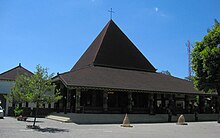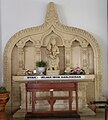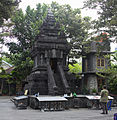Ganjuran Church
| Ganjuran Church | |
|---|---|
| Church of the Sacred Heart of Jesus Gereja Hati Kudus Yesus Gereja Ganjuran | |
 Exterior of the church, from the front | |
 | |
| 7°55′35.69″S110°19′8.38″E/ 7.9265806°S 110.3189944°E | |
| Location | Ganjuran, Bambanglipuro,Bantul Regency,Special Region of Yogyakarta |
| Country | Indonesia |
| Denomination | Roman Catholic |
| Membership | 8,000 (2011) |
| History | |
| Status | Parish church |
| Founded | 16 April 1924 |
| Founder(s) | Schmutzer family |
| Dedication | Sacred Heart of Jesus |
| Architecture | |
| Functional status | Active |
| Architectural type | Javanese European |
| Specifications | |
| Number ofspires | 1 |
| Administration | |
| Archdiocese | Semarang |
| Parish | Ganjuran |
TheChurch of the Sacred Heart of Jesus(Indonesian:Gereja Hati Kudus Yesus), also known as theGanjuran Church(Indonesian:Gereja Ganjuran), is aRoman Catholicchurch located in Ganjuran,Bantul,Special Region of Yogyakarta,Indonesia. It is the oldest church in itsadministrative regency.[1]
The church was established on 16 April 1924 by the Schmutzer family, who owned a sugar factory in the area. From a total of 25 Catholics in the area in 1922, the congregation has expanded to 8,000 in 2011. The building has seen many modifications, including reconstruction after the2006 Yogyakarta earthquake.Much critical commentary has been made on itsJavanesedesign, and the church continues to includeJavanese culturein its liturgy.
Description
[edit]
Ganjuran Church is located in Ganjuran, Bambanglipuro,Bantul,17 kilometres (11 mi) south ofYogyakarta.It is built on 2.5 hectares (6.2 acres) of land and in addition to the church has a parking lot,temple(candi), residence for pastors, and other maintenance buildings. As of 2011[update],its total congregation is 8,000, consisting mostly of farmers, merchants, and labourers.[2]
The main church building is ajogloand is decorated with 600 square metres (6,500 sq ft) of traditional Javanese carvings, including parallelograms known aswajikanand wooden pineapples.[1][3]The altar features angels dressed aswayang orangcharacters.[4]Because of this architecture, the Dutch scholar of IndonesiaM. C. Ricklefshas described the church at Ganjuran as perhaps one of the most dramatic manifestations of the Catholic Church's accommodations ofJavanese culture,[5]while the scholars Jan S. Aritonang and Karel A. Steenbrink described the church as "the most spectacular product of... European-guided indigenous art".[6]
History
[edit]The land on which Ganjuran Church is now located was once part of a sugar factory, run by the Dutch brothers Joseph and Julius Schmutzer. In 1912 they began practising workers' rights as outlined in theencyclicalRerum novarum;[2]they then began working on establishing educational facilities on the land, with seven boys' schools opened in 1919 and a girls' school opened in 1920.[7]They also promoted Catholicism amongst their employees.[6]With the proceeds from their factory, the Schmutzers established St Elisabeth Hospital in Ganjuran, first as a clinic.[8]They also established Onder de Bogen (nowPanti Rapih Hospital) in Yogyakarta proper.[7]St Elisabeth is now managed by the Order of Carolus Borromeus.[8]
Also in 1920, Pr. van Driessch, a member of theSociety of Jesuswho had taught at Xaverius College inMuntilan,began giving sermons and working to establish a Catholic community in the area. By 1922 there were 22 nativeJavaneseCatholics, a number that increased rapidly.[9]On 16 April 1924 the Schmutzers established a church on their grounds, with van Driessch as its first pastor.[10]The carvings and other facets were worked on by a Javanese sculptor named Iko.[6]

Three years later the congregation began construction of a 10-metre (33 ft) tallHindu-styled temple(candi), resembling the one atPrambanan Temple;[7][11]Iko set statues ofMaryandJesusas Javanese royalty and teachers, which were adorned withbatikmotives.[6]Stones were taken from the slopes ofMount Merapito the north, while the entrance was pointed to southern sea; this orientation reflected a Javanese belief in the harmony between north and south.[12]The temple was consecrated on 11 February 1930 byBishop of BataviaAntonius van Velsen.[10]
Van Driessch died in 1934[13]and was replaced by Jesuit FatherAlbertus Soegijapranataas pastor;[10]Soegijapranata served concurrently as pastor of Ganjuran and Bintaran. In this year the congregation totalled 1,350 people.[8]The Schmutzers returned to the Netherlands that year. During theIndonesian National Revolutionthe sugar factory was razed, but the schools, church, and hospital survived. In 1947 Fr.Justinus Darmojuwonobecame pastor, serving until 1950.[10]
In 1981 the accommodations for pastors were expanded under Suryosudarmo,[10]and seven years later, under Fr. Gregorius Utomo, the church began emphasising its Javanese influences. In 1990, theFederation of Asian Bishops' Conferencesheld a conference on agriculture and farmers' issues. Since 1995 the church has focused on its temple, and through donations has addedreliefsdepicting fifteenStations of the Cross;[14]the reliefs had initially been planned by the Schmutzers.[4]After the old church was destroyed in the2006 Yogyakarta earthquake,the church was redesigned in a Javanese style.[1]The reconstruction costRp7 billion (US$900,000).[3]
Activities at the church include regularMass,economic programmes, and celebrations of special events.[15]Liturgy can be inJavaneseor Indonesian, and at times Javanese attire is required.[1]There may also begamelanmusic andkeroncongperformances.[3]
Gallery
[edit]-
Church interior
-
The altar ofSang Maha Prabu Yesus Kristus Pangeraning Para Bangsa(Our Lord Jesus Christ, King of all Nations)
-
The altar ofDyah Mariyah Ibu Ganjuran(Our Lady, Mother of Ganjuran)
-
Marian grottoof the church
-
Hindu-style temple at the church, the main shrine of the Sacred Heart.
-
Balinese dancein front of the temple
-
Gateway to the church
-
Front gate of the church
See also
[edit]References
[edit]- ^abcdSusanto 2012, Spreading the spirit.
- ^abUtomo 2011,p. 2.
- ^abcSusanto 2009, Easter celebration.
- ^abRicklefs 2007,p. 122.
- ^Ricklefs 2007,p. 121.
- ^abcdAritonang & Steenbrink 2008,p. 927.
- ^abcUtomo 2011,p. 3.
- ^abcSubanar 2003,p. 109.
- ^Subanar 2003,p. 110.
- ^abcdeUtomo 2011,p. 4.
- ^Aritonang & Steenbrink 2008,p. 929.
- ^Subanar 2003,pp. 112–113.
- ^Subanar 2003,p. 108.
- ^Utomo 2011,p. 5–7.
- ^Utomo 2011,p. 8–13.
Sources
[edit]- Aritonang, Jan S.; Steenbrink, Karel A., eds. (2008).A History of Christianity in Indonesia.Studies in Christian Mission. Vol. 35. Leiden: Brill.ISBN978-90-04-17026-1.
- Ricklefs, Merle Calvin (2007).Polarising Javanese Society: Islamic and Other Visions, C. 1830-1930.Leiden: KITLV Press.ISBN978-9971-69-346-6.
- Subanar, G. Budi (2003).Soegija, Si Anak Bethleham van Java[Soegija, the Son of the Javanese Bethlehem] (in Indonesian). Yogyakarta: Kanisius.ISBN978-979-21-0727-2.
- Susanto, Slamet (7 April 2009)."Easter celebration Javanese style in Ganjuran".The Jakarta Post.Archived fromthe originalon 30 July 2009.Retrieved4 July2012.
- Susanto, Slamet (30 March 2012)."Spreading the spirit of sharing".The Jakarta Post.Archived fromthe originalon 3 April 2012.Retrieved4 July2012.
- Utomo, Gregorius (2011).The Church of the Sacred Heart of Jesus at Ganjuran.Yogyakarta: Unggul Jaya.ISBN978-979-16933-1-8.










